Are you looking for the best inks for miniature painting? Or, maybe you’re looking for how to use inks on miniatures and making ink washes? Inks are different than regular acrylic paints for painting miniatures. They are a highly-pigmented liquid art medium that usually requires thinning or mixing with other media for best results on miniatures. Not all ink brands or types are the same. Some inks are acrylic-based, while others are resin-based media. In fact, there’s no strict definition of “ink”. Suffice it to say, if you’re painting Warhammer 40k, Infinity, Military or Historical gaming models, or even 3D printed miniatures, inks are a great tool for your palette.
In this article, I highlight some of the key features and uses of colored inks that are important for painting minis and models. I also review the top 15 recommended inks for painting miniatures and models.
In a hurry? Take a look at the top 3 editor’s picks! 🥇
- Daler Rowney FW Acrylic Artist Ink (Most popular)
- Golden Transparent Highflow Acrylic (Versatile/Airbrush ready)
- Games Workshop/Citadel Shade (Easy to use)
Here are the best 15 inks for painting miniatures and models:
- Privateer Press P3 Inks
- Games Workshop/Citadel Shade
- Golden Transparent Highflow Acrylic
- Vallejo Inks
- Warcolours Inks
- Reaper Master Series (Liner Ink)
- Army Painter Quickshade
- Badger Ghost Tints
- Scale 75 Inktensity
- Andrea Color Inks
- Daler Rowney FW Acrylic Artist Ink
- Liquitex Inks
- Winsor & Newton Drawing Inks
- Dr. P.h. Martin’s Bombay India Ink
- Amsterdam Acrylic Ink
Continue reading for more details about inks and miniature painting and the review of the top 15 inks!
What’s the difference between “inks” and “washes”?
When comparing “inks vs. washes” you need to know that the line is blurry.
But, I’ll give it a shot!
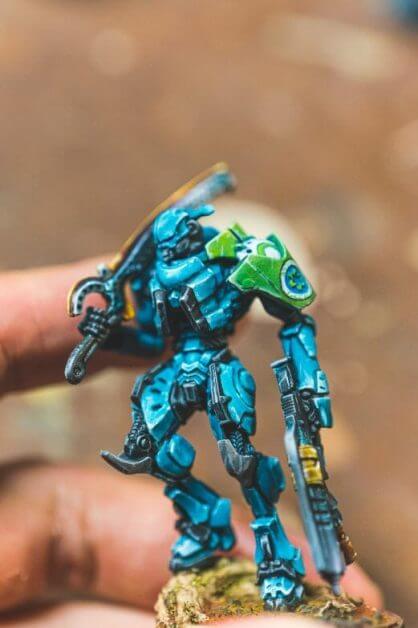
Inks
Artist inks are a liquid paint medium and usually much less viscous (e.g., thinner) than any regular paint. Most inks use liquid dyes instead of finely ground pigments for color. Inks also have a high-level of color saturation (or color pigment density) thant regular paint. For miniature painting, this means that you can often dilute an ink to a much greater extent without losing color intensity or depth.
Dyes vs. pigments: A dye is a colored chemical substance that directly bonds to a surface. This makes dyes different from pigments, which do not chemically bind to the material they color. Inks made with pigment coloring require a “binder”, such as acrylic or resin polymer, that cures/dries on the applied surface.
Inks are great for freehanding because they flow more easily off your brush bristles and have excellent coverage. Because inks are thinner and have high color intensity, they are also a useful alternative for thinning other model acrylic paints (here’s a great example of using inks for thinning other paints). If you’re airbrushing your model, inks are a quick and easy way to glaze over a zenithal highlight base coat.
Washes
Washes are a thinned version of paint designed to flow into the recesses of a surface. Usually, washes are a darker color that helps you add contrast to a miniature. Army Painter Quickshade is a great example of a wash that rapidly adds contrast to a model. Using a wash will bring out details in a model by darkening the deeper textures in a model’s surface. You can make your own washes simply by adding extra water to thin your regular acrylic paints.
Of course, a good wash will go where you want it to go, and dry evenly without cracking or creating “rings”. You add other art mediums to your DIY washes, or buy pre-made washes that will skip the tedium of figuring out the correct mixture ratios.
RELATED: USE WATERCOLOR PAINT AS A WASH
Liners
Liners are highly-pigmented dark-colored inks. These inks are named for their intended purpose, which is to “line” the edges and elements of your model. Use liners like a reversed coloring-book: darken the colored elements of your miniature to make each part stand out. Reaper Paint has specific liners that that are designed to flow well off your brush and darken edges quickly.
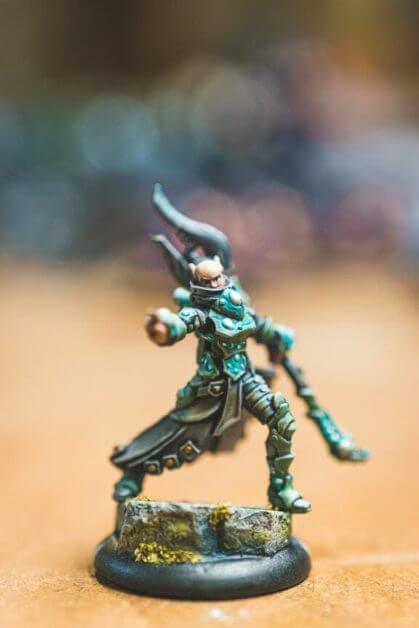
I find liners very useful, and you can see examples of miniatures I painted with these liners in my gallery.
Can you use artist inks on miniatures?
Yes!
Of course, but here are 5 specific uses for what you can use inks for on miniatures when you’re painting:
- Basing models (see video)
- Mixing with other model paints
- Making DIY washes
- Glazing
- Airbrushing
In general, the best inks for painting miniatures let you do some or all of these applications.
RELATED: BEST ACRYLIC MODEL PAINT SETS FOR PAINTING MINIATURES
1. Basing models
If you’re basing models with sand, flock, or other material, and want to add color, inks are great.
This is what you do:
Mix your ink with a flow improver. Add water to thin this down your ink mixture, and apply liberally on your model’s base.
You’ll find the ink will “flow” easily across the texture of your miniature’s base. Ink will shift or filter the color of whatever you apply it to.
2. Mixing with other model hobby paints
Mixing inks with other model paints does two amazing things: 1) it will thin your hobby paints without using water (which prevents loss of binding properties of the paint, and 2) shifts and deepens the color saturation of your paint.
In other words, mixing ink with your miniature paints adds vibrancy and color depth. Some may call this effect “filtering” (like the filters you use on your photos for Instagram). If used skillfully, your models will pop with color in a unique way that regular paints cannot achieve. Win painting competitions with inks!
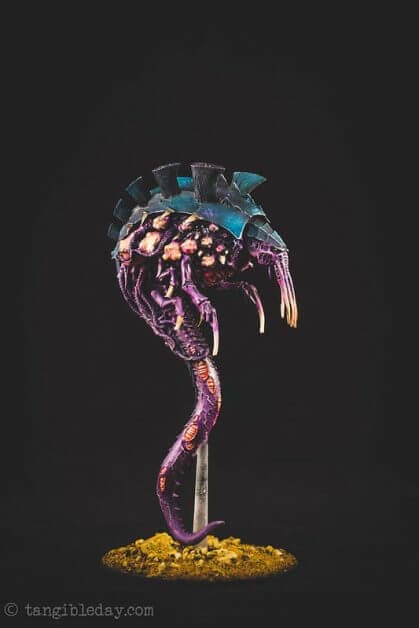
3. Make DIY washes
The best inks for making washes have high pigment color intensity. A wash is simply colored-pigment thinned sufficiently to flow into recesses. Inks make it a lot easier to create your own washes. This is because inks have more intense color that doesn’t diminish with heavier thinning.
RELATED: CAN YOU MAKE YOUR OWN CONTRAST PAINTS?
Here’s a quick place to start experimenting with using DIY washes with inks.
Mix about 8 parts acrylic medium (any brand, or use what’s below), 3-4 parts highly-pigmented ink, and 2 parts flow improver.
- Acrylic medium (8 parts) – This is a binding medium that helps your mixture stick to your miniature.
- Scale 75 inktensity (3-4 parts) – You can use any ink, this is just an example.
- Winsor Newton flow improver (2 parts) – Flow improver helps the wash mixture “flow” across surfaces and into deeper recesses. You could just use water if you want a “thicker” mixture. (Note: As per manufacturer instructions, you should work only from a diluted stock of “1 part flow aid in 10 part water” before use in a DIY wash).
Remember to experiment!
4. Glazing with inks
A glaze is any color art medium that you apply over surface to change the overall color. It’s like a colored filter that you place directly over your painted surfaces.

Inks are great at glazing because they are so color intense. The best inks for glazing miniatures dilute well and easily in water. For many inks, you’ll want to thin them to avoid oversaturating your painted model. If you’re unsure how much color to add to your miniature, you can always thin your inks more and apply subsequent layers. Just remember to let each layer dry before applying the next.
MORE: HOW TO GLAZE MINIATURES
To make a glaze with inks, simply add water (or any appropriate artist thinning medium) until the ink is diluted and transparent.
I like using ink glazes over zenithal highlighted models to quickly add color while maintaining high-contrast. Inks are amazing for miniature painting because they are so versatile!
5. Airbrush miniatures with inks
Most inks are already thin enough for you to airbrush without thinning them further. Just be aware that some inks airbrush better than others. For example, I would avoid airbrushing India inks (which usually have coarsely ground pigments) as they tend to splatter and clog up airbrushes than other inks.
These inks also tend to bind-up the internals of moving parts if left to dry in an airbrush. A good rule for best results is to always clean your airbrush after spraying with inks.
The effect of airbrushing inks is similar to regular paints. You can coat miniature surfaces quickly for base-coating, or use a thinned version of ink to glaze over different parts of your model. A highly regarded miniature artist, Sergio Calvo, uses an airbrush for glazing as part of his workflow.
If you’re unsure what inks a good for airbrushing, I would start with water-based acrylic inks. The best acrylic inks for airbrushing miniatures are Golden’s High Flow acrylics or Liquitex inks. These inks are thin and atomize well with any airbrush.
RELATED: BEST AIRBRUSHES FOR MINIATURES AND MODELS
Can you use alcohol ink on miniatures?
No, I do not recommend using alcohol based inks on miniatures. Alcohol based inks are designed for paper, not surfaces that can be scratched off at a later date.
The ink would dry to the area it had been applied to before quickly rubbing off if you tried to use it on any type of “hard” surface. You can, however, use alcohol-based markers or sharpies, which are specially designed to adhere well enough to almost any surface, including miniatures. Just be sure to apply a varnish over your completed paint job to protect your work.
Must-know ink features for miniature painting
Not all inks are created equal. You should consider a few things when looking for an ink when painting miniatures and models.
Here are the key features of inks you need to know:
Gloss finish
Almost all inks are glossy when dry. In fact, almost all acrylic paint mediums are naturally glossy due to their chemical make-up. Model hobby paints formulated for miniatures have additional ingredients that tone-down the glossy finish without losing color coverage/density (which also tends to add cost).

Dye or pigment density (color intensity)
Inks have very high color intensity, due in part to the dyes or amount of pigment in them. Different brands have different levels of color intensity or depth. Liquitex Inks and Scale 75 Inktensity brands, for example, have some of the highest amounts of color intensity for miniature painting inks.
To properly use these inks, you will want to thin these down with water or other artist media. Of course, some inks are “transparent” and allow underlying colors to show through. You’ll have to experiment a little to know how a particular inks behaves on your palette and miniature.
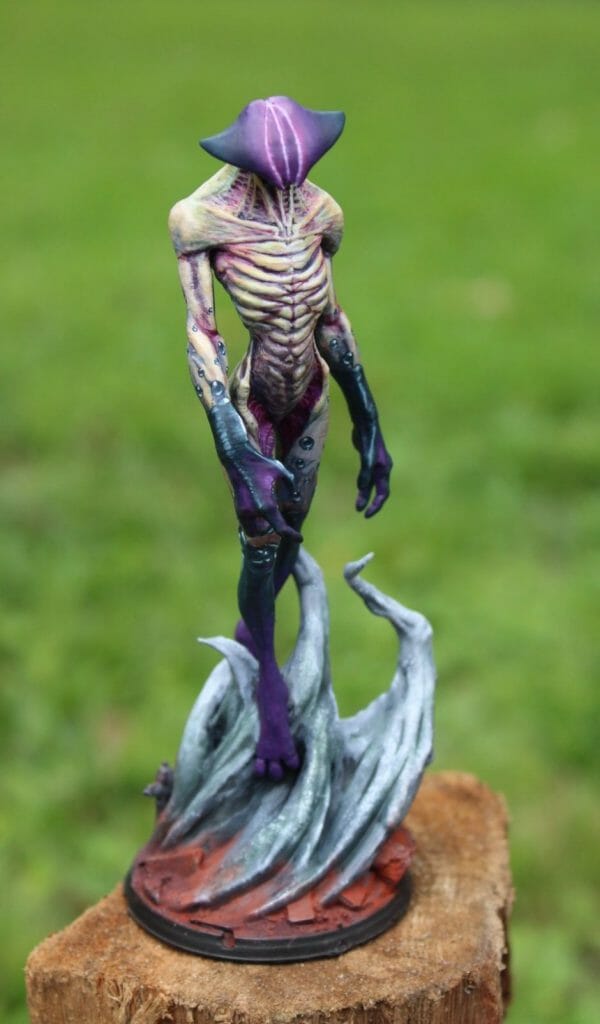
Pigment size
Not all inks use pigment for coloring. But, for those inks that use pigments, such as India inks, you’ll want to know how this may affect your paint job. Fine pigmented inks will behave like most inks. But for inks with coarse pigments, you’ll want to be aware that they can clog up your instruments, brushes, and clump-up if not properly applied.
Acrylic or resin-based inks
Acrylic based inks are the easiest to use. They can be thinned and washed-off with water. Resin-based inks are more resilient and permanent, but require a bit more work to clean, e.g., may require alcohol to clean your brushes. Resin-based inks may also be toxic, so avoid licking your brushes (read more about the danger of brush licking). Dr. Ph. Martin’s Bombay India Inks are resin-based inks.
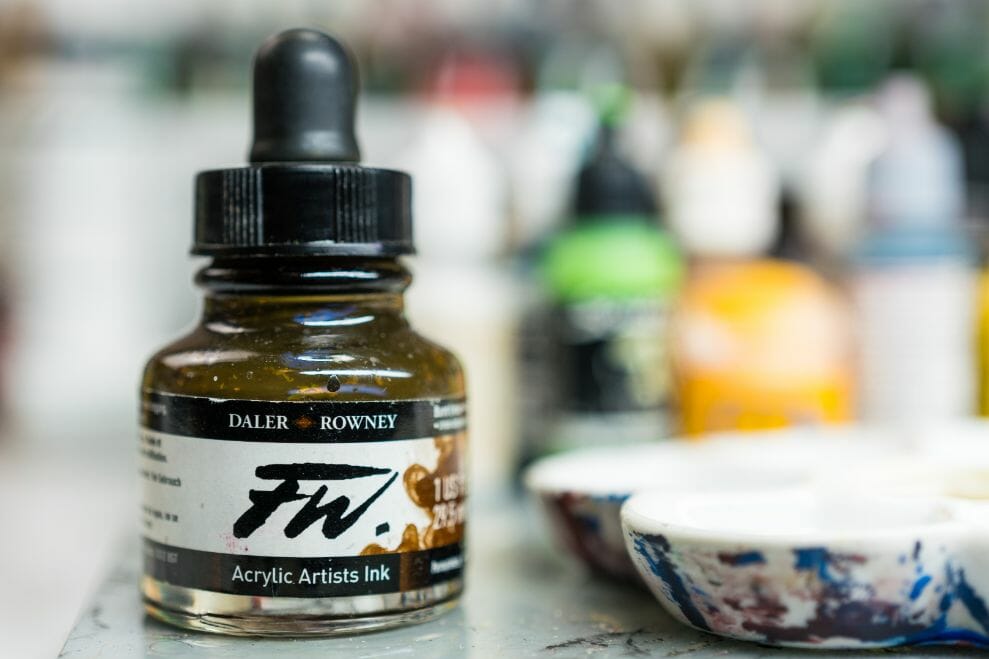
Ultraviolet (UV) light fade resistance (Lightfast)
Some inks are more resilient to fading than others. Lightfastness is generally good amongst all modern artist inks. Note that shellac is an ingredient in some inks, which adds color and unique resiliency to dried ink.
However, inks with shellac are vulnerable to fading when exposed prolonged heat or UV, e.g., sunlight. This isn’t a problem for most miniature paintings, as we tend to keep our precious work away from windows and being left under direct sunlight.
Water solubility
Almost all inks are water-based liquid mediums, and therefore soluble in water. Water is a great medium for thinning inks for many purposes, e.g., glazing. Even alcohol-based inks dissolve well in water (but may behave unpredictably). When you’re painting miniatures with any ink, you can rest assured that water is your best go-to medium for working with inks.
Dry time
The amount of working time you have with particular ink will depend on many factors, i.e., brand, ambient temperature and humidity, and other additives in your ink. You will have to experiment with your inks to determine how long it takes to dry. In my experience, inks tend to take a bit longer to dry than regular miniature model paints.
Bottle shape/size
Don’t want your inks to spill everywhere? Buy inks that come with bottom-wide bottles. Avoid inks that come in tall shaped containers, like Citadel pots. I also tend to prefer ink pots with squeeze-bulb eye droppers if they are available. They make transferring inks to your palette much easier without the mess of drips across your work space (or inadvertently on your model).
Most inks actually come with flip dropper tops, e.g., Vallejo style, or glass pipettes built into the cap.
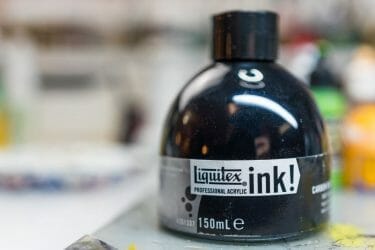
Cost
The price of ink varies greatly. I find the most cost-effective inks are artist grade inks you can get at art stores. But, to use these properly you need to know how to use them to get the best results. Hobby “inks” are often similar in price per bottle, but you get much less volume. However, hobby grade inks are formulated for accessibility. For example, Games Workshop Citadel Shades or Contrast Colours are worth their cost because of their ease-of-use. See more about this below.
Top 15 Best Inks for Painting Miniatures and Models
Here are my 15 recommended best inks for painting miniatures and models:
I have a few of these inks in my paint collection. My favorite P3 ink colors are turquoise and flesh (which also doubles as my rust color effect in NMM painting). In my experience, the armor (black/dark gray) wash is also a pretty good alternative to Citadel’s Nuln oil. However, you’ll need to dilute it down since it is so dark. Brown is also a great P3 ink color and works great for leather or even dried gore special effects (e.g., dab the ink around the edges).
If you blend in a little red paint, P3 brown ink gives clothing a nice color depth that is hard to achieve with paint alone. The dried version of P3 inks is somewhat glossy, but not too bad compared to other inks out there.
P3 inks work great as glazes, mixed into other normal paints, or as washes. P3 inks are very thin and runny, but have a beautiful color intensity that makes them easy to work with and versatile.
Citadel shades are the best do-it-all “ink” solution for new painters (or veterans). Although not branded as “ink” per say, Citadel shade paints have the same thin consistency and act like inks. Most Citadel shades are more transparent than your normal artist grade inks. A part of this reason is because they contain other additives that make them accessible to anyone without needing to know how to mix your own color “cocktail”. They just work!
RELATED: BEST 26 CITADEL PAINTS TO COLLECT
Citadel shades work best straight out of the pot. No diluting necessary. What is great about the Citadel shade is that they do exactly their namesake: shade. They add a darkened version of the color you’re applying to your model. Because they flow easily, they preferentially darken the recesses of your miniature’s surface.
You can airbrush Citadel shades, too. I have a few examples and uses of these paints elsewhere, and you will find they work great as a glaze, too. Some would say that Games Workshop (GW) overpriced these shade pots. But, what you get in return is a huge time-saving convenience.
Golden Transparent Highflow Acrylics are one of my favorite go-to inks for airbrushing. They are color intense, thin-viscosity acrylic inks that flow easily from your regular brushes or airbrush. A few things to note: Golden high flow acrylics dry quickly and have a nice transparency to them (e.g., colors underneath show through layers of this paint). I use the black and white paints to help me zenithal paint models, and work with the transparent paints to thin other colors or as glazes.
Highflow inks/paints dry glossy. So, if you’re looking for a matte finish, then remember to varnish (here’s how). The twist cap is also convenient for dispensing just the right amount of color you need. Finally, for the cost, you get a lot of color to work with, which makes the Highflow Acrylic Set a great value. I have not run out of a single color in the few years since using these acrylic inks for painting miniatures.
4. Vallejo Inks
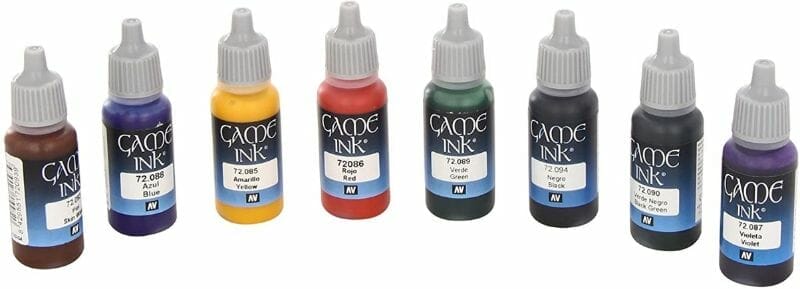
Vallejo inks are formulated for miniature painting. They dry a bit glossy, but all you need to do is spray a matte varnish when you’re done painting to remove the shine. In many regards, these inks work similar to the Daler Rowney Acrylic inks (below). They come in a range of useful colors and thin well with water, if you’re making a wash or glaze.
Vallejo inks are the best for gaming miniatures because of their durability. Additionally, Vallejo inks are the best inks for color intense projects where you want a lot of color in your paint job. Mix them with other paints to add color depth, for example. But, be careful not to use them like a “wash” straight from the bottle.
They have a lot of colored pigment and will overwhelm your entire model with their color shade. If in doubt, do a test application on something that isn’t your main working surface.
Warcolour inks have a base of shellac (a natural product that adds sheen and warmth) that ensures a smooth and predictable flow characteristic on your miniatures. Warcolour inks have some of the most useful color palettes in miniature painting, allowing you to get just the right hue/shade on your model. These inks are best applied by a regular brush thinned with a bit of water, but can work equally well in an airbrush with some practice.
Use Warcolour inks as a glaze to shift your underlying colors in subtle ways and help you blend transitions in your paint layers. Because they are soluble in water, Warcolour inks work great with other water-based art media, thinning mixtures, or other acrylic paints. For 20 bottles in the set, you get quite a lot of options making these some of the better valued inks for miniature painters.
Reaper Master Series liner inks are a more opaque ink for painting miniatures. They are ideal for “lining” the edges of models to help visually distinguish different parts of your painted miniature. If you missed it, click here for more about washes, inks, and liners. The Grey and Brown liners are the most popular and versatile in my opinion.
I love using liners for other purposes, too, in my model painting. You can thin them with water to create a glaze for darkening specific parts of your model. They blend easily with simple brush feathering. The Reaper Liner paints also use really fine pigment, so you can smooth out your transitions without dark spots or splotchy bits.
If you want to make your own wash, Reaper Liner ink is great because of how well they mix with water, and will flow (and stay) into the recesses of your model.
Here’s a useful tip with Reaper liners: Apply a water-thinned mixture over a white or other bright-colored base coat to help you fill in all the shadow details before you apply regular colored paint. This will help you decide where to place your midtones and highlights. Make sure to let the liner dry before moving to more painting. By leaving portions of the liner exposed (without painting over it), you can also skip the “wash” or shading phase of your paint job.
The Army Painter Quickshade Wash set is a bit different than artists inks and other hobby brand “inks”. The Army Painter Quickshade set uses media that is a bit more viscous (thicker) with a heavier, darker color tonal range. The most popular washes in the Army Painter Quickshade set are the soft, strong, and dark tone.
READ MORE: HOW TO USE QUICKSHADE TO SPEED PAINT MINIATURES
Note that the “dark-tone” is a black-like color, and will give you an almost cartoonish look by filling in the cracks and recesses on your model. The other “tones” will give you a more realistic or grimy look, depending on which one you use and how you apply it. These colors are a brown-ish hue with darkening values, and useful for a wide variety of applications.
In speed painting, I tend to recommend these Quickshade washes for adding contrast, quickly. Of course, Army Painter washes and paints tend to separate in their bottles if left alone for a while. Make sure you shake them vigorously for best results. You can do what I do and use a small automated paint shaker.

The colored quickshade washes are like dark inks with a lot of color intensity. They will, however, flow nicely into crevices on your model and work great as a wash (with a bit of thinning). As with other inks, you may want to experiment with how you use them. Remember, a best practice with inks is to apply them in thinned layers until you understand how they look.
Badger Ghost Tints are a unique line of transparent inks distributed by the Badger Airbrush company. They are airbrush-ready colored “inks” that are optimized for airbrushing at low air pressure. As transparent colors, they work like candy colors or “candies”, but formulated for working on miniatures and models as water-soluble acrylics.
MORE: HOW TO USE A MATTE VARNISH TO REMOVE PAINT SHINE
Ghost Tints dry fast and stick well to painted miniature surfaces. They work essentially as clear glossy glazes. A creative way to use Ghost Tints is to use them to create colored-metallics. Apply them over a silver/steel colored metallic basecoat, and change the color of the metal without removing the metallic shine.
You can see some of the examples of what Ghost Tints look in my Gallery, especially this Warhammer 40k tank. The blackened front of the cannon was airbrushed with Ghost Tint “Oil Discharge”, which creates a compelling burnt carbon looks on weaponry. The Plasma Blue Ghost Tint makes for a fast and easy glow effect when brush-on (with a regular brush) over a white painted basecoat.
Ghost Tints are so versatile that if you’re looking for a set of helpful “special effect” paints, these transparent inks my recommended choice.
Scale 75 Inktensity inks are a line of basic ink colors. Even more so than other inks, the Inktensity line dries very glossy, almost wet-looking. To work with these inks, I mix in a few drops of matte medium, which helps take down the shine and thin out the intense color.
Other painters work with Inktensity inks by mixing them with regular colours. Because of their color intensity, these inks are best used when you want good coverage but need a thinner version of paint. It doesn’t take much of this ink mixed with regular paint to shift color hues or tones, either. They are that strong.
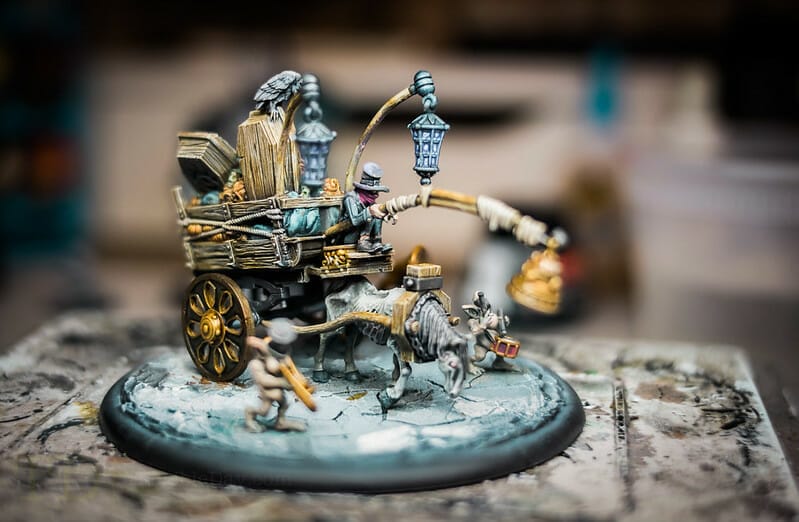
I’ve airbrushed Inktensity colors in many of my organic type models. For example, I used my airbrush with these inks (thinned a lot with water) to glaze interesting colors over a base of skin tone. Of all the colors in the Inktensity line, I think the best color is the Inktense Wood color. After a zenithal undercoat to add black and white contrast to your model texture, glaze Inktense Wood and watch your surface material transmutate into realistic looking wood.
Make sure you don’t use too much water when thinning Inktensity colored inks, however. They tend to dry fast and clump up when thinned too much. I’m not sure why this is, but the formulation that makes them so color intense probably has something do with it.
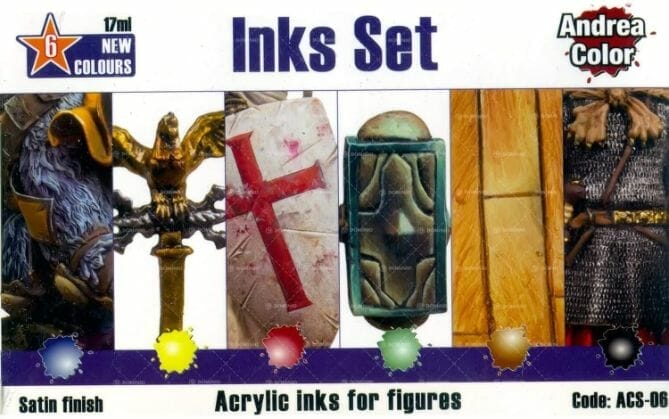
Andrea Color Inks are not the most popular inks for miniature artists. On the other hand, their acrylic model paint line for scale models and miniatures is highly-regarded. In general, the Andrea Color Inks have a more satin finish than other hobby acrylic inks (which are usually glossy) when they are dry.
You can use these inks like other inks by thinning a little with water and glazing vibrant colors to add interest to your miniatures. Or, use them as a way to add vibrancy to your regular acrylic paints.
The ink comes in 17 ml dropper bottles, which is similar in size to Vallejo and are best dispensed in a dry palette (here are a few affordable dry palettes I recommend for working with thin media). The viscosity would make working with these inks on a wet palette difficult unless you were mixing them more viscous acrylic paint.
If you’ve been a miniature painter for a while, then you’ll immediately know that Daler Rowney FW Acrylic Inks are some of the most popular for the hobby. Not only are they incredibly versatile as hobby inks, but Daler Rowney Inks come in a wide variety of colors that you dispense with built-in eye droppers. This makes use them much easier because you can control how much you’re adding to your mixtures or directly to your palette (drop by drop).

As an acrylic ink, Daler Rowney FW acrylic inks are best used in combination with other techniques for creating glazes and washes. Use them to tint your miniatures with a very thin solution (mixed with water). Glaze using an airbrush or regular brush, whatever you prefer; it all works well with these inks. I like adding flow improver to the Burnt Umber color for painting the bases of my models. This creates a realistic dirt-like appearance without a lot of work.

Daler Rowney white ink is also great for airbrushing zenithal highlights over a dark color or black basecoat. I’ve use this ink painting technique for speed painting Warhammer and Age of Sigmar models.
At some point I hope to collect all of the ink colors!
Other favorite colors of Daler Rowney Inks for painting miniatures is Payne’s Gray and Burnt Sienna, which work great for shading and creating realistic leather and wood effects. These inks also work well with an airbrush. Don’t over thin these inks with water, or else you’ll lose their bind properties. Try mixing with an airbrush thinning medium. Vallejo makes an airbrush thinner that I love for most painting applications with inks.
12. Liquitex Inks
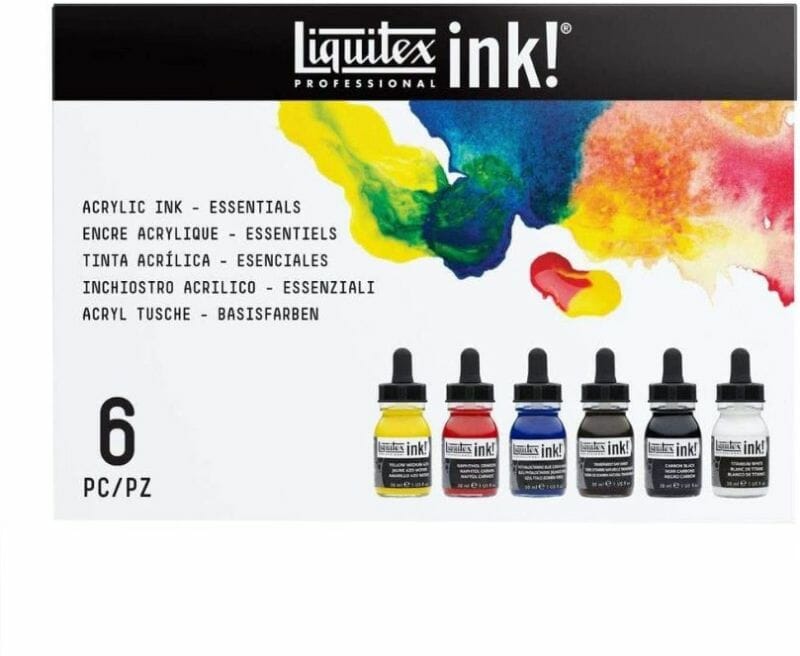
Liquitex Ink is also another favorite art ink. Remember that thinning artist ink with too much water will create problems with low adhesion and runny pigments. Make sure you add a little acrylic medium (like matte medium) to maintain control with diluted ink. Like Daler Rowney inks, I love how Liquitex inks come with convenient dropper tops that help you dispense ink in small droplets.
As an acrylic ink, Liquitex Ink mix well with water for creating washes and glazes. You can also use these inks as regular paints, applying them as a basecoat. They have excellent color/pigment density and have great coverage. You will want to varnish your miniatures, however, after using artist inks like these to prevent them from rubbing off (they aren’t the most durable colors).
What I love about artist inks is how color intense they are, which allows you to work quickly and see results fast.
Winsor & Newton Drawing Inks are water soluble dyes dissolved in a shellac solution. This makes these inks permanent and best for drawing and writing on paper with dip pens. However, for the miniature artist, they are also useful for painting with “transparent” color using your brush.
I have a set of these for my fountain pens and find them fun to use when I’m looking to change things up in my miniature paintings. They are not lightfast and will fade a bit in bright sunlight (UV exposure). Make sure you varnish your models when you finish painting to keep the colors bright and saturated.
Dr. Bombay India inks are probably as popular as Daler Rowney inks for painting miniatures. This is likely because they are easily found in most hobby and art stores in your neighborhood. A benefit to India inks is that they are light fast and won’t fade over time.
However, Dr. Martin’s Bombay India Inks are resin-based rather than purely acrylic. This means that although they mix well with other acrylic paints, they may be harder to clean from your brushes and other tools. Also, these inks may be toxic so avoid brush licking. To wash them off, rubbing alcohol works well. Additionally, try to avoid using your expensive kolinsky sables with this ink, because it will stain your bristles and could clump up if not properly cleaned off.
Amsterdam Acrylic Ink is a highly pigmented and waterproof ink that you can use with your brush or airbrush. The main benefit of these acrylic inks is they are easy to find in art stores and are inexpensive for what you get. These acrylics are a thicker than other acrylic inks in my experience. You will have to shake these bottles pretty hard to get the pigments to mix well (you could use a shaker).
For best results, mix lower cost acrylic artist inks with acrylic mediums to keep them flowing and binding to your model in smooth layers. If you over thin these with water, you may find grainy clumps of pigment. In my experience, for these kinds of acrylic inks, I tend to mix them in with my regular paints to switch up the color profile.
Ultimately, I think artist inks are best for painting miniatures with loads of organic shapes and thinned with other paints so you can accent base colors without overwhelming your piece.
Conclusion
I love having artist acrylic inks on-hand for quick pops of color. I highly encourage anyone to experiment with inks. You’ll be amazed at what effects you’ll come up with. Whether you’re painting miniatures for wargames, like Warhammer 40k, Fantasy, or historical wargames, inks are a unique and versatile medium that can add realism (or not) to your work.
I am always looking for different paints and tools to experiments with in the hobby world.
I hope you enjoyed this article and found it useful. If you have any comments or feedback for this article, I’d love to hear from you! Comment below 😃
Happy painting!

Tangible Day on YouTube (Miniatures and More!)

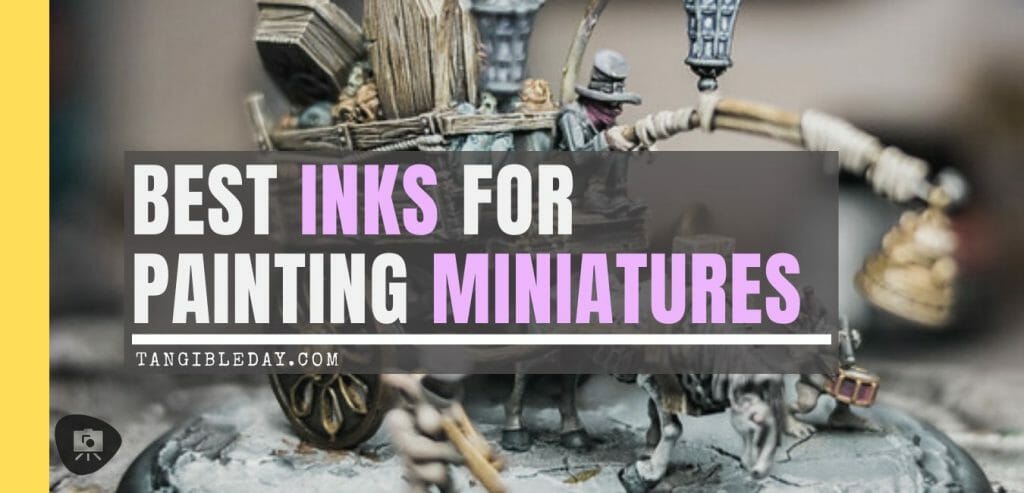
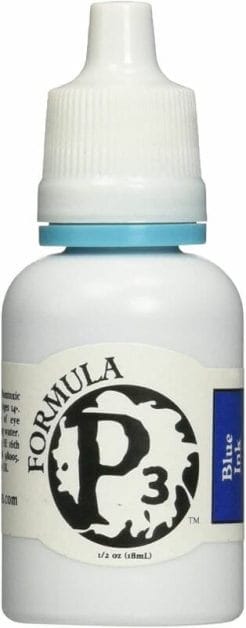
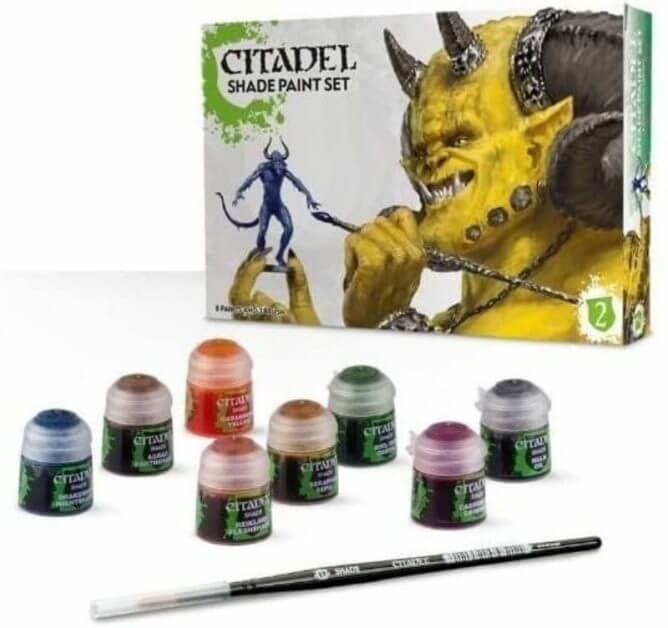

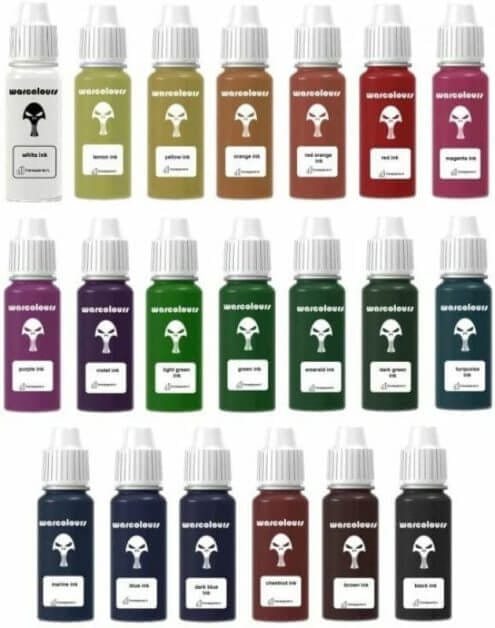


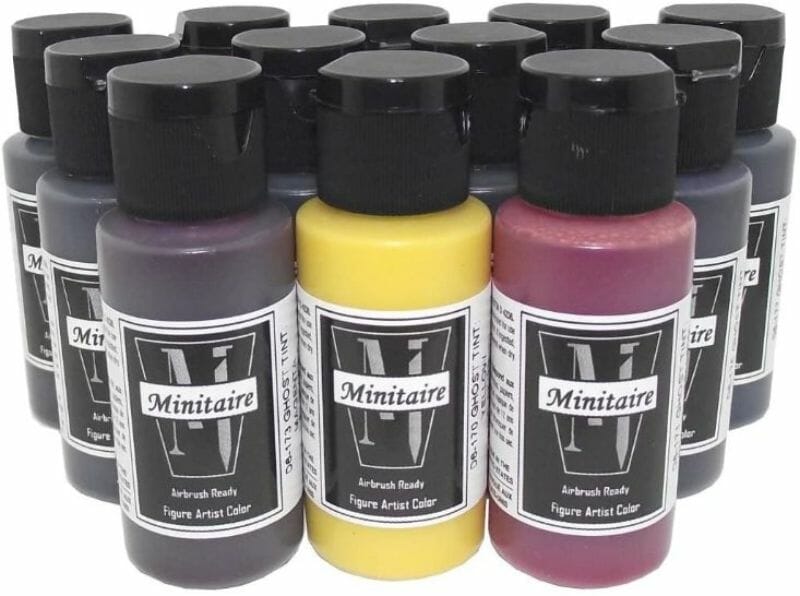
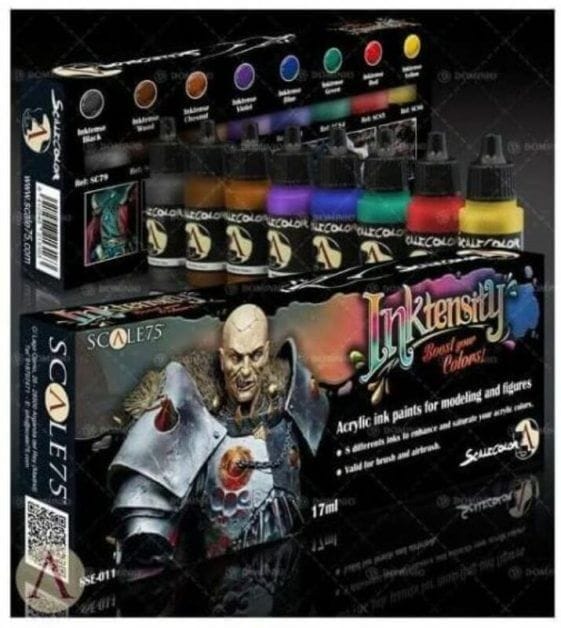

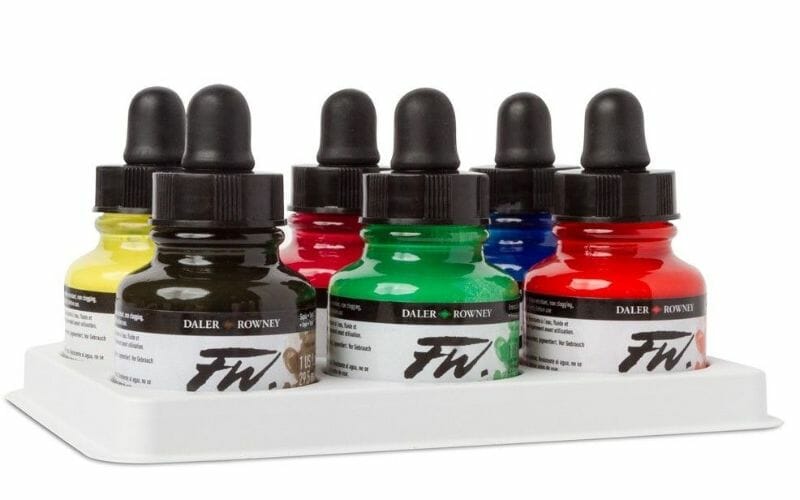
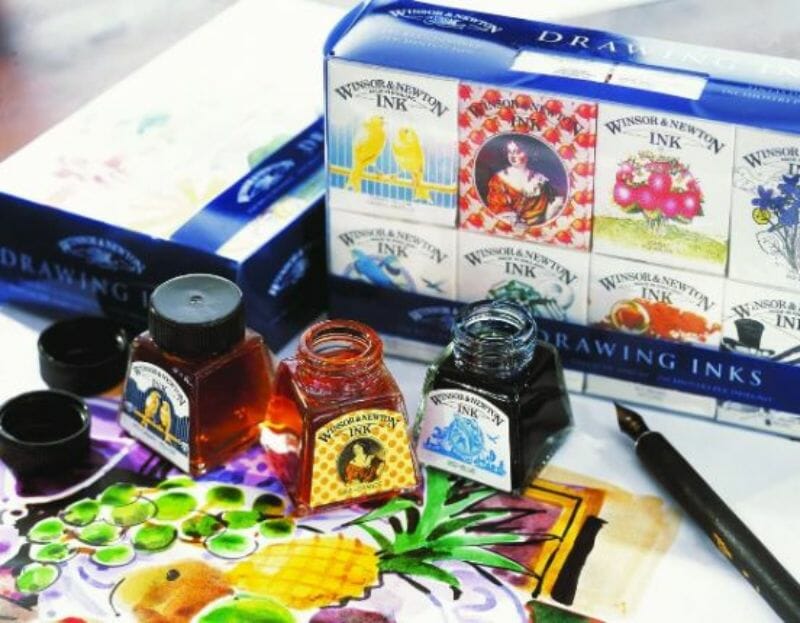
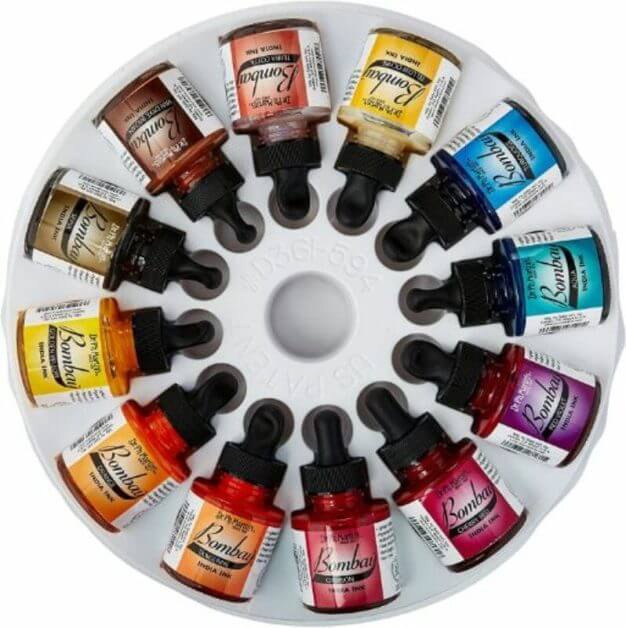

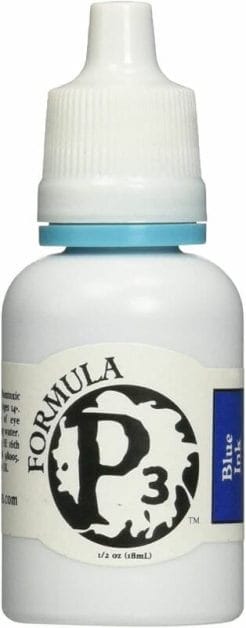
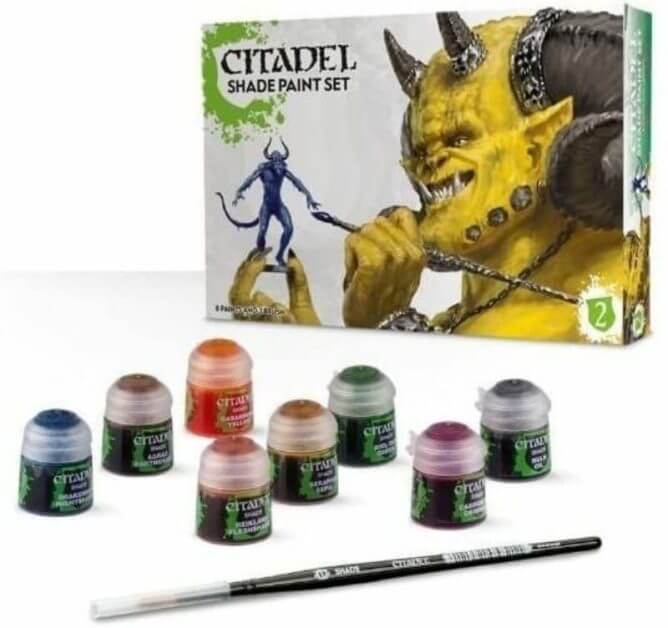
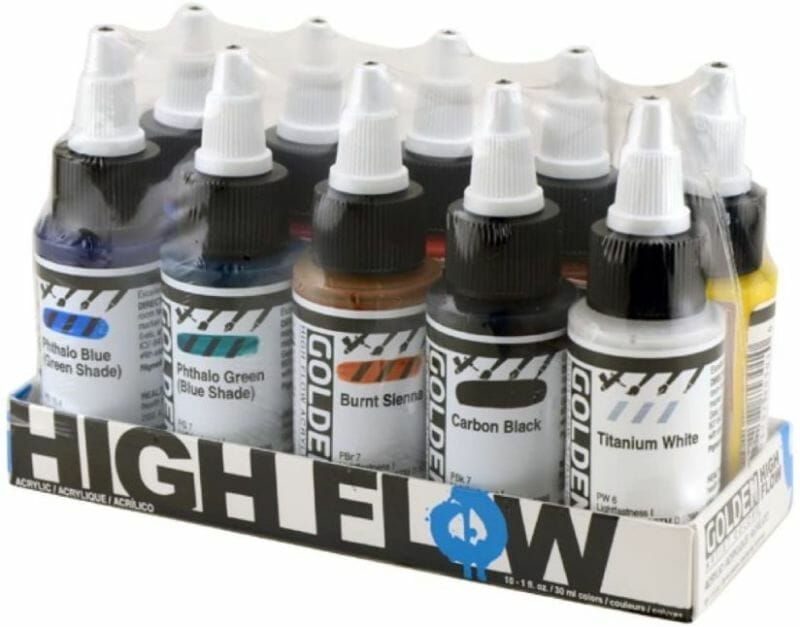
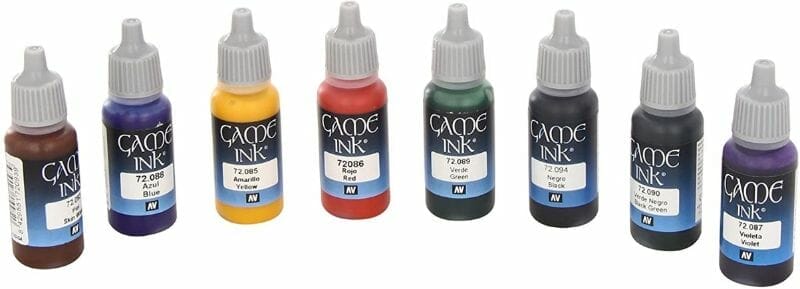


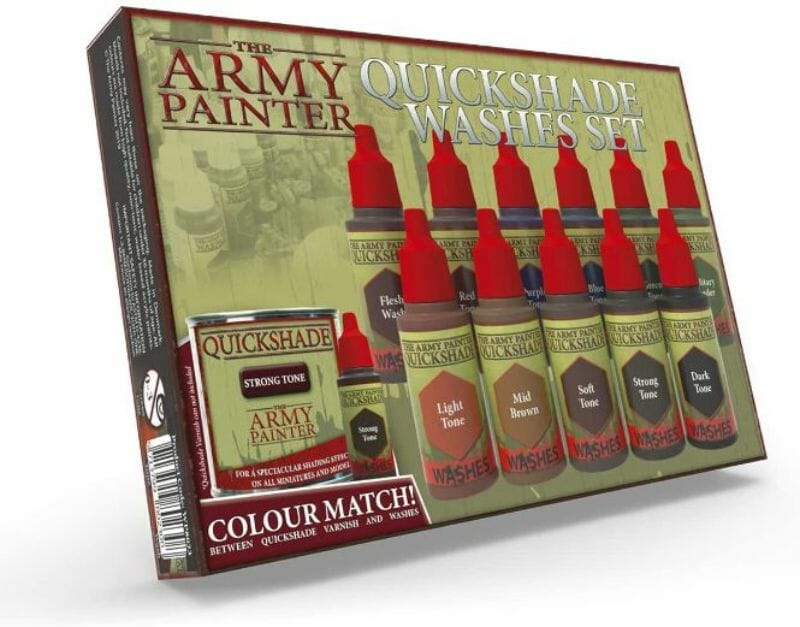
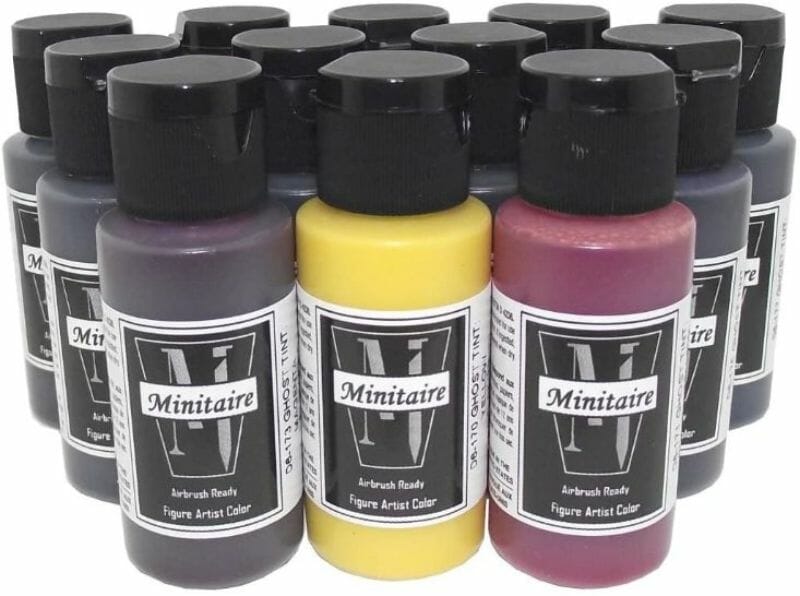
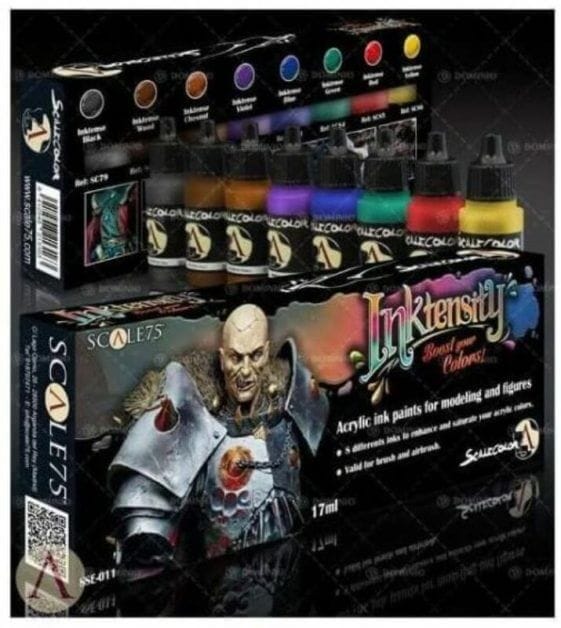



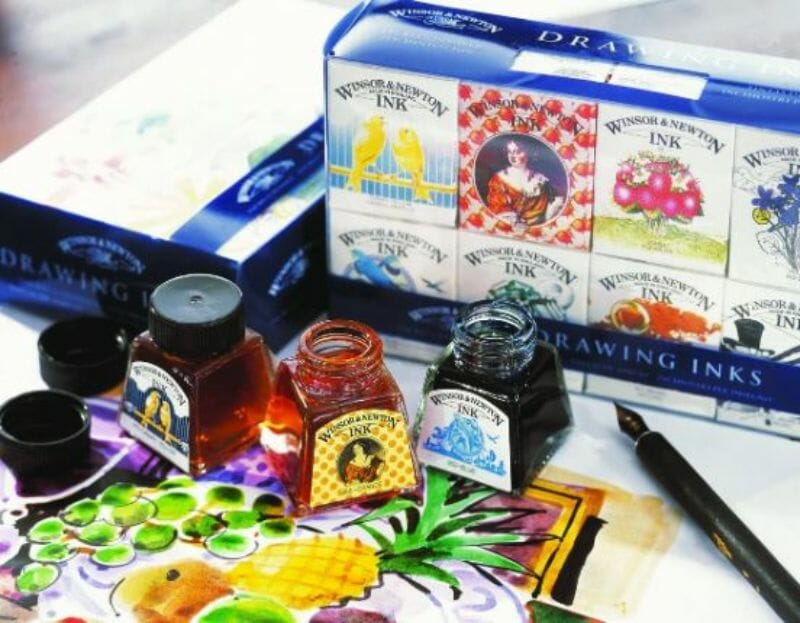
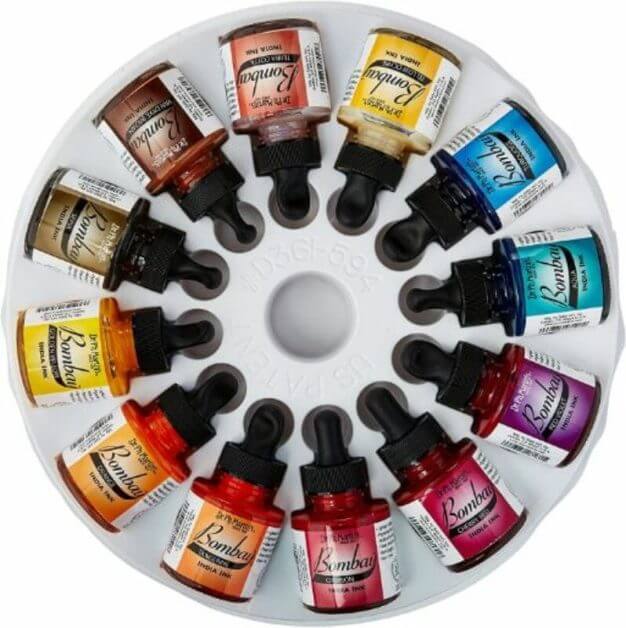
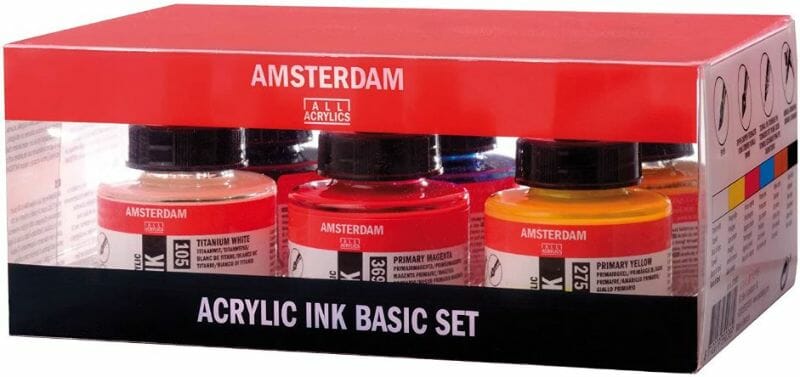
A very nice guide. I use the GW washes a lot as they’re very forgiving at my level of painting. I’m also a big fan of W&N’s Peat Brown ink and tend to use it a lot to represent mud and leather.
Awesome. Yeah the Citadel washes are great for their easy of use. Just dip and go. I like using Daler Rowney inks mixed with a bit of flow improver to paint dirt, mud, or other woody effects. For leather I tend to simply use Citadel Agrax Earthshade and highlight with the base color afterwards.
Thanks for this article. My son uses inks on his minis and I’m looming into using them as washes on my 1/72nd a/c builds and figures.
I appreciate the comment! Inks are great for the mini painting hobby 🙂
When you say “2 parts” flow improver, do you mean straight flow improver, or diluted 10/20:1?
Good question – I’ll update the text in the article. I mean the diluted version of the flow improver (10:1), then (2 flow improver:1 paint).